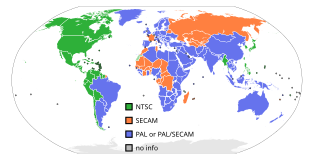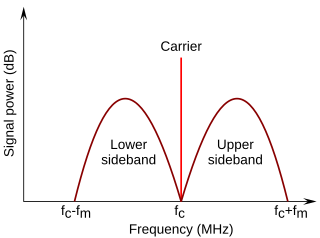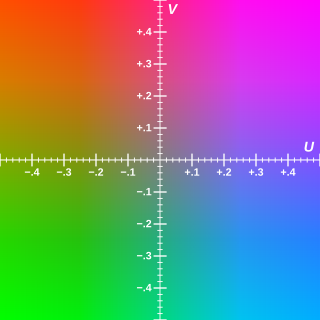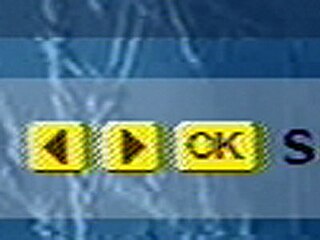
Analog television is the original television technology that uses analog signals to transmit video and audio. In an analog television broadcast, the brightness, colors and sound are represented by amplitude, phase and frequency of an analog signal.

Chrominance is the signal used in video systems to convey the color information of the picture, separately from the accompanying luma signal. Chrominance is usually represented as two color-difference components: U = B′ − Y′ (blue − luma) and V = R′ − Y′ (red − luma). Each of these difference components may have scale factors and offsets applied to it, as specified by the applicable video standard.

The first American standard for analog television broadcast was developed by the National Television System Committee (NTSC) in 1941. In 1961, it was assigned the designation System M.

Phase Alternating Line (PAL) is a colour encoding system for analogue television. It was one of three major analogue colour television standards, the others being NTSC and SECAM. In most countries it was broadcast at 625 lines, 50 fields per second, and associated with CCIR analogue broadcast television systems B, D, G, H, I or K. The articles on analog broadcast television systems further describe frame rates, image resolution, and audio modulation.

SECAM, also written SÉCAM, is an analog color television system that was used in France, Russia and some other countries or territories of Europe and Africa. It was one of three major analog color television standards, the others being PAL and NTSC. Like PAL, a SECAM picture is also made up of 625 interlaced lines and is displayed at a rate of 25 frames per second. However, due to the way SECAM processes color information, it is not compatible with the German PAL video format standard. This page primarily discusses the SECAM colour encoding system. The articles on broadcast television systems and analog television further describe frame rates, image resolution, and audio modulation. SECAM video is composite video because the luminance and chrominance are transmitted together as one signal.

A heterodyne is a signal frequency that is created by combining or mixing two other frequencies using a signal processing technique called heterodyning, which was invented by Canadian inventor-engineer Reginald Fessenden. Heterodyning is used to shift signals from one frequency range into another, and is also involved in the processes of modulation and demodulation. The two input frequencies are combined in a nonlinear signal-processing device such as a vacuum tube, transistor, or diode, usually called a mixer.

In radio communications, a sideband is a band of frequencies higher than or lower than the carrier frequency, that are the result of the modulation process. The sidebands carry the information transmitted by the radio signal. The sidebands comprise all the spectral components of the modulated signal except the carrier. The signal components above the carrier frequency constitute the upper sideband (USB), and those below the carrier frequency constitute the lower sideband (LSB). All forms of modulation produce sidebands.

Y′UV, also written YUV, is the color model found in the PAL analogue color TV standard. A color is described as a Y′ component (luma) and two chroma components U and V. The prime symbol (') denotes that the luma is calculated from gamma-corrected RGB input and that it is different from true luminance. Today, the term YUV is commonly used in the computer industry to describe colorspaces that are encoded using YCbCr.

Colorburst is an analog video, composite video signal generated by a video-signal generator used to keep the chrominance subcarrier synchronized in a color television signal. By synchronizing an oscillator with the colorburst at the back porch (beginning) of each scan line, a television receiver is able to restore the suppressed carrier of the chrominance (color) signals, and in turn decode the color information. The most common use of colorburst is to genlock equipment together as a common reference with a vision mixer in a television studio using a multi-camera setup.

Composite video is an analog video format that typically carries a 525 or 625 line signal on a single channel, unlike the higher-quality S-Video and the even higher-quality component video.

SMPTE color bars are a television test pattern used where the NTSC video standard is utilized, including countries in North America. The Society of Motion Picture and Television Engineers (SMPTE) refers to the pattern as Engineering Guideline (EG) 1-1990. Its components are a known standard, and created by test pattern generators. Comparing it as received to the known standard gives video engineers an indication of how an NTSC video signal has been altered by recording or transmission and what adjustments must be made to bring it back to specification. It is also used for setting a television monitor or receiver to reproduce NTSC chrominance and luminance information correctly.

A Vectorscope is a special type of oscilloscope used in both audio and video applications. Whereas an oscilloscope or waveform monitor normally displays a plot of signal vs. time, a vectorscope displays an X-Y plot of two signals, which can reveal details about the relationship between these two signals. Vectorscopes are highly similar in operation to oscilloscopes operated in X-Y mode; however those used in video applications have specialized graticules, and accept standard television or video signals as input.

NTSC-J or "System J" is the informal designation for the analogue television standard used in Japan. The system is based on the US NTSC (NTSC-M) standard with minor differences. While NTSC-M is an official CCIR and FCC standard, NTSC-J or "System J" are a colloquial indicators.

Dot crawl is a visual defect of color analog video standards when signals are transmitted as composite video, as in terrestrial broadcast television. It consists of moving checkerboard patterns which appear along horizontal color transitions. It results from intermodulation or crosstalk between chrominance and luminance components of the signal, which are imperfectly multiplexed in the frequency domain.
MUSE, commercially known as Hi-Vision was a Japanese analog high-definition television system, with design efforts going back to 1979.
Colour recovery is a process which can restore lost colour to television programmes which were originally transmitted from the colour video tape which the original master was recorded on during final production prior broadcast, but for which only black and white copies remain archived. This should not be confused with colourisation, in which colour is artificially added to source material that was always black-and-white, or used to enhance poor-quality original sources. Colour recovery is a newer process and is fundamentally different from colourisation. Most of the work has been done on PAL signals due to the BBC, but the concept is not fundamentally restricted to this system.
Differential gain is a kind of linearity distortion that affects the amplification and transmission of analog signals. It can visibly affect color saturation in analog TV broadcasting.
Differential phase is a kind of linearity distortion which affects the color hue in TV broadcasting.
Composite artifact colors is a designation commonly used to address several graphic modes of some 1970s and 1980s home computers. With some machines, when connected to an NTSC TV or monitor over composite video outputs, the video signal encoding allowed for extra colors to be displayed, by manipulating the pixel position on screen, not being limited by each machine's hardware color palette.

The EBU colour bars is a television test card used to check if a video signal has been altered by recording or transmission, and what adjustments must be made to bring it back to specification. It is also used for setting a television monitor or receiver to reproduce chrominance and luminance information correctly. The EBU bars are most commonly shown arranged side-by-side in a vertical manner, though some broadcasters – such as TVP in Poland, and Gabon Télévision in Gabon – were known to have aired a horizontal version of the EBU bars.



















